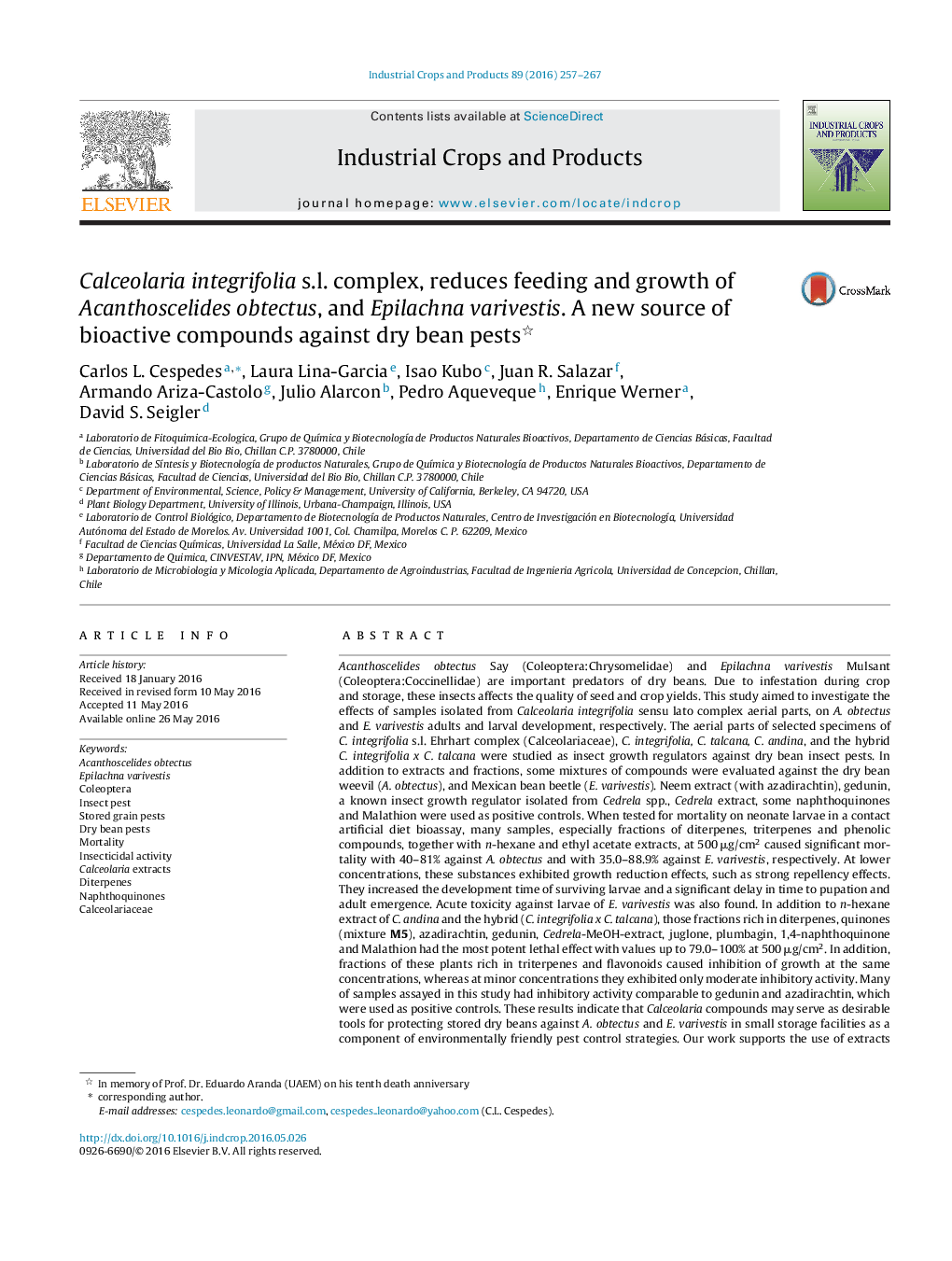| کد مقاله | کد نشریه | سال انتشار | مقاله انگلیسی | نسخه تمام متن |
|---|---|---|---|---|
| 4512126 | 1624821 | 2016 | 11 صفحه PDF | دانلود رایگان |

• Extracts and fractions from C. integrifolia sensu lato complex showed inhibitory activity against A. obtectus and E. varivestis.
• The IC50 concentration was between 150.0–500.0 μg/ml of samples.
• Highest inhibition 88.9 and 99.0% at 500 μg/ml of samples rich in naphthoquinones.
• Samples rich in diterpenes and naphthoquinones were the most active.
• At low concentrations these compounds showed effect as insect growth regulators.
Acanthoscelides obtectus Say (Coleoptera:Chrysomelidae) and Epilachna varivestis Mulsant (Coleoptera:Coccinellidae) are important predators of dry beans. Due to infestation during crop and storage, these insects affects the quality of seed and crop yields. This study aimed to investigate the effects of samples isolated from Calceolaria integrifolia sensu lato complex aerial parts, on A. obtectus and E. varivestis adults and larval development, respectively. The aerial parts of selected specimens of C. integrifolia s.l. Ehrhart complex (Calceolariaceae), C. integrifolia, C. talcana, C. andina, and the hybrid C. integrifolia x C. talcana were studied as insect growth regulators against dry bean insect pests. In addition to extracts and fractions, some mixtures of compounds were evaluated against the dry bean weevil (A. obtectus), and Mexican bean beetle (E. varivestis). Neem extract (with azadirachtin), gedunin, a known insect growth regulator isolated from Cedrela spp., Cedrela extract, some naphthoquinones and Malathion were used as positive controls. When tested for mortality on neonate larvae in a contact artificial diet bioassay, many samples, especially fractions of diterpenes, triterpenes and phenolic compounds, together with n-hexane and ethyl acetate extracts, at 500 μg/cm2 caused significant mortality with 40–81% against A. obtectus and with 35.0–88.9% against E. varivestis, respectively. At lower concentrations, these substances exhibited growth reduction effects, such as strong repellency effects. They increased the development time of surviving larvae and a significant delay in time to pupation and adult emergence. Acute toxicity against larvae of E. varivestis was also found. In addition to n-hexane extract of C. andina and the hybrid (C. integrifolia x C. talcana), those fractions rich in diterpenes, quinones (mixture M5), azadirachtin, gedunin, Cedrela-MeOH-extract, juglone, plumbagin, 1,4-naphthoquinone and Malathion had the most potent lethal effect with values up to 79.0–100% at 500 μg/cm2. In addition, fractions of these plants rich in triterpenes and flavonoids caused inhibition of growth at the same concentrations, whereas at minor concentrations they exhibited only moderate inhibitory activity. Many of samples assayed in this study had inhibitory activity comparable to gedunin and azadirachtin, which were used as positive controls. These results indicate that Calceolaria compounds may serve as desirable tools for protecting stored dry beans against A. obtectus and E. varivestis in small storage facilities as a component of environmentally friendly pest control strategies. Our work supports the use of extracts from C. species both as fumigants, repellent and contact bioinsecticides against stored product pests for crops of economic importance.
Figure optionsDownload as PowerPoint slide
Journal: Industrial Crops and Products - Volume 89, 30 October 2016, Pages 257–267